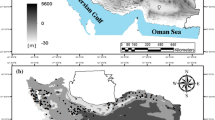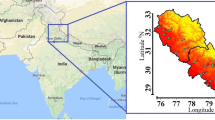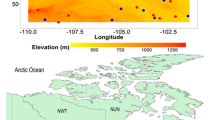Abstract
This paper focused on future precipitation scenarios adopting statistical downscaling approach, namely, Multiple linear regression (MLR) for Lower Godavari basin, India. Global Climate Model (GCM), namely, GFDL-CM3 simulations, are used for downscaling purpose. Five grid points of Lower Godavari basin are considered. Reanalysis data from National Centre for Environmental Prediction (NCEP) of the study area from 1969 to 2005 is used for analysis. Precipitation is chosen as predictand. Representative Concentration Pathways (RCPs) scenarios, 4.5 and 6.0 are used for the study. Projected precipitation from 2006 to 2100 is obtained by the developed MLR model. Downscaled precipitation predictions show that there is increase in precipitation in the future.
Access provided by CONRICYT-eBooks. Download conference paper PDF
Similar content being viewed by others
Introduction
Climate change is becoming a challenge in the global environment. Continued emissions of greenhouse gases would further increase the existing risks and create new ones for society and ecosystems (IPCC 2014). In this regard, it is required to predict the future climate changes to analyze its possible impacts in a river basin. Global Climate Models (GCM’s) are one of the approaches available for assessing change in climate. In addition, statistical downscaling approaches are becoming important due to their ability to derive quantitative relationship between local surface variables, i.e., predictands and large-scale atmospheric variables, i.e., predictors (Wilby and Wigley 1997). This study has been taken to synthesize the future precipitation scenarios adopting statistical downscaling approach, namely, Multiple Linear Regression (MLR) for Lower Godavari basin, India using the simulations of GCM, GFDL-CM3. Present paper covers the literature review, study area, methodology, results and discussion followed by summary and conclusions.
Literature Review
Numerous studies have been carried out for assessing the climate change impact adopting various downscaling approaches. Schoof and Pryor (2001) conducted a study to downscale temperature and precipitation using regression and Artificial Neural Networks. They compared the performance of downscaling models and discussed the possible improvements. It was concluded that performance of ANN’s was clearly superior to MLR. Tatli et al. (2004) carried out a study to downscale monthly total precipitation over Turkey. They observed that a large-scale analysis is required due to the existence of complex relationships between large-scale processes and local atmospheric conditions. Fowler et al. (2007) presented state-of-the-art review on downscaling techniques for hydrologic modeling applications. They suggested applied research that can handle future uncertainties.
Hashmi et al. (2009) presented a study to deal uncertainty aspects associated with statistical downscaling of monthly precipitation in a watershed by applying a Bayesian framework to develop Weighted Multi-Model Ensemble (WMME). They strongly supported multi-model ensemble downscaling for hydrological impact assessment. Goyal and Ojha (2010) analyzed various linear regression models as a part of downscaling for the case study of Pichola lake region in Rajasthan. The results of the study indicated that direct regression outperformed all other methods.
Similar studies were made by Meenu et al. (2012) for Tungabhadra river basin, India; Latt and Wittenberg (2014) for multi-step forecasting of Chindwin River floods, northern Myanmar; Elhakeem et al. (2015) for United Arab Emirates (UAE).
It is observed from literature review that statistical downscaling approaches are useful and can be used as the basis for adaptation studies. Keeping this in view, it is felt necessary to study the effect of climate change on precipitation for the case study of Lower Godavari Basin, India. Summing up, the following objectives have been carried out:
-
(a)
To study the applicability of MLR as statistical downscaling approach.
-
(b)
To generate future precipitation at the basin level.
Study Area
The study area, Lower Godavari Basin starts from the river’s confluence with the Manjira to the mouth which lies between North latitudes 16° 19′–19° 03′ and East longitudes 80° 01′–82° 94′. Godavari basin has a tropical climate. Comparatively the weather is hotter in the western most parts of the basin as compared to the northern, central and eastern regions. Southwest monsoon is the major source of rainfall. Variation of annual rainfall of the basin is from 755 to 1531 mm whereas average annual rainfall is 1096.92 mm over a period of (1971–2005). Variation of annual maximum temperature is from 31 to 33.5 °C over a period of (1969–2004) (Godavari River Basin 2014). Accordingly predictor variables are chosen in the study to arrive at the future climatic scenario in the basin.
Methodology
Selection of Predictors and Predictands
Lower Godavari Basin is divided into 5 grid points for the present study based on the grid resolution available for the India Meteorological Department (IMD) data, i.e., 17.5N–80.5E, 17.5N–81.5E, 18.5N–81.5E, 18.5N–80.5E, 18.5N–82.5E. All the data were processed using following steps (Fig. 1).
Precipitation (Prec) is chosen as predictand in downscaling methodology. In this regard, historical monthly data of Prec for the five grids of Lower Godavari Basin was obtained from the IMD, for the period of 1969–2005 (baseline period). Predictors were established for predictand and presented in Table 1. All the chosen predictors are interdependent which collectively affect the change in precipitation. Hence it is expected to obtain a relationship between the predictands and predictors which would essentially help to evaluate performance of downscaling process (Anandhi et al. 2009; Mujumdar and Nagesh Kumar 2012).
NCEP reanalysis data of the study area have been taken from 1969 to 2005 for the listed predictor variables (Table 1) and used for calibration along with IMD data. Once the model is developed, it can be used for generating future scenarios from GCM data. This data is obtained at a grid resolution of 2.5° × 2.5° (latitude × longitude) on a daily scale and averaged to obtain monthly scale data (http://pcmdi9.llnl.gov/esgf-web-fe).
Selection of GCM and Representative Concentration Pathways (RCPs)
Choosing a suitable GCM is a crucial step as it decides the outcome of the study. Chaturvedi et al. (2012) suggested GFDL-CM3 for both temperature and precipitation. Hence, GCM outputs of GFDL-CM3 have been considered from 2006 to 2100 for projecting future scenarios of precipitation (Akshara 2015).
GFDL-CM3 was developed by Geophysical Fluid Dynamics Laboratory of USA. The model has a resolution of 2° × 2.5° (latitude × longitude) covering 90 × 144 global grids. Information about input data is presented in Table 1. The GCM data for RCP 4.5 and RCP 6.0 are used in this study (IPCC 2014). Interpolation technique is used to bring the data at common resolution for comparative purposes.
Data Preparation
The first step in climate modeling is to acquire observed meteorological data relevant to the study area. The future time series has been developed using MLR technique with predictor variables of NCEP and GFDL-CM3 (RCP4.5 and RCP6.0) data sets which are described below:
NCEP 1969–2005: Set contains 37 years of normalized daily observed predictor data, extracted from NCEP reanalysis.
GFDL-CM3 (RCP4.5 and RCP 6.0): 1969–2100: This set contains 132 years of monthly predictor data, derived from the GFDL-CM3, RCP 4.5 and RCP 6.0 experiments, normalized over the 1969–1998 (30 years) period.
Statistical Downscaling
MLR analysis is used as the statistical downscaling approach to find the degree of interrelationship among number of variables. The initial screening of predictor variables has also been performed (Ghosh and Mujumdar 2008; Wilby and Dawson 2013).
Results and Discussion
Regression analysis is performed with respect to each grid and R 2 is evaluated. p5_u, p8_u, p8_v, p500, p850, mslp, hurr, hurs are the chosen predictors after screening for grids 1, 2, 3, and 4 whereas p8_v, p500, p850, mslp, hurs for grid 5. Both the dependent variable and the independent variables are organized grid-wise and are given as input to the linear regression. Five regression equations are formulated with respect to each of the five grids considered in the study area. The calculated R 2 has been found in the range of 0.596–0.696 and grid 4 has the highest R 2 value compared to all other grids. Overall, the regression models are found to be satisfactory. These inferences were based on the outputs related to five grids and innumerable trial and errors conducted on varying combinations of predictors.
Application of Downscaled Scenarios for Future Periods
The standardized GCM predictors for the period 2006–2100 are now introduced in the models developed by calibrating the IMD observed data with NCEP predictor variables for the baseline period (1969–2005) to project the future precipitation for both the scenarios, i.e., RCP 4.5 and RCP 6.0. Three time periods 2020s (2020–2029), 2050s (2050–2059) and 2080s (2081–2089) were considered in order to observe the changes occurring in these periods.
Analysis for Grid 1: 17.5N–80.5E
It is observed from Fig. 2 (for RCP 4.5) that there is minimum precipitation in January and December and maximum in July and August; the trend for future precipitation exhibits intermediate peaks in April; the change in precipitation is significant from baseline period to 2020s as well as 2020s–2050s. It is observed from Fig. 3 (for RCP 6.0) that precipitation is increasing on the whole. Heavy precipitation can be expected in July and August; Precipitation before and after monsoon followed a decreasing pattern with monsoon period as a center in the baseline period. It is not the same with future periods; the maximum precipitation observed in 2020s is 9 mm/month, 2050s is 14 mm/month and in 2080s 19 mm/month.
Analysis for Grid 2: 17.5N–81.5E
It can be inferred (for RCP 4.5) that precipitation decreases by a small amount for 2020s in the post-monsoon and increases significantly for all months in 2050s and 2080s relative to baseline period; It is noted that precipitation in 2020s in few months coincides with that of baseline period; Significant changes in precipitation are observed from 2020s to 2050s rather than 2050s to 2080s. It is observed (for RCP 6.0) that maximum precipitation occurs in July and August and minimum is observed in January and December. Precipitation is following a zig zag pattern in the first five months. The post-monsoon rains have also increased by a considerable amount.
Analysis for Grid 3: 18.5N-80.5E
It is noted that (for RCP 4.5) amount of precipitation is very high in June, July and August and there is very little amount of precipitation in January and December. There is a significant increase in precipitation from 2020s to 2050s whereas the difference from 2050s to 2080s is slightly low. The precipitation has gradually decreased for winter season and increased for post monsoon as observed for RCP 6.0. The peak value is observed in July for all time periods. The maximum precipitation in 2080s is expected to be around 34 mm in July.
Analysis for Grid 4: 18.5N–81.5E
It is observed for RCP 4.5 that changes in precipitation is very large from 2020s to 2050s whereas very small change is observed from 2050s to 2080s. Peak is observed in August for all time periods; Precipitation is following a zig zag pattern in the first 5 months. The post-monsoon rains have also increased by a considerable amount. Precipitation is increasing gradually from one time period to another. The difference between baseline period to 2020s is observed to be very low whereas the difference between successive time periods has increased gradually (for RCP 6.0). Precipitation follows an increasing trend from January to March and decreases up to May and then increases gradually till the month of August and then decreases till December, but compared to baseline, the amounts of precipitation have increased significantly in all future periods considered.
Analysis for Grid 5: 18.5N–82.5E
There is a gradual decrease in increase of precipitation in pre-monsoon and post-monsoon period and significant increase in monsoon period for RCP 4.5. Precipitation in winter has reduced by a great amount; no significant decrease is observed in precipitation change from 2050s to 2080s. It can be inferred from RCP 6.0 scenario that precipitation increased gradually till April and a decrease in trend is formed in May; whereas June, July and August have the highest amounts of precipitation compared to the remaining months; January and December are reported to be the driest months.
Summary and Conclusions
Linear Regression analysis is applied to Lower Godavari Basin. The predictor variables of NCEP from 1969 to 2005 are used to develop the relationship with observed monthly precipitation obtained from IMD. The relationship obtained by regression analysis is used to predict the monthly precipitation using the surface predictors obtained from GCM outputs. The GFDL-CM3 has been used in present study.
Downscaled precipitation predictions show that there is an increase in the amount of precipitation in the future. Precipitation for all the grids on an average has increased from 8 to 10 mm/month in the baseline period to 20–25 mm/month in 2080s. Considering the RCP’s, no noticeable difference between RCP 4.5 and RCP 6.0 is observed except for slight variations in few months. Amount of precipitation will be very high from June to August and very low in January and December.
The present study is based on the chosen GCM, RCPs, and downscaling approach. The results may vary depending on the chosen combinations. However, focus of the present work is to suggest a methodology that can be replicated in due course of time depending on the availability of data and resources.
References
Akshara G (2015) Downscaling of climate variables using multiple linear regression—a case study, Lower Godavari Basin, India. M.E Thesis, BITS Pilani Hyderabad Campus, Hyderabad, India
Anandhi A, Srinivas VV, Kumar DN, Nanjundiah RS (2009) Role of predictors in downscaling surface temperature to river basin in India for IPCC SRES scenarios using support vector machine. Int J Clim 29:583–603
Chaturvedi RJ, Joshi J, Jayaraman M, Bala G, Ravindranath NH (2012) Multi-model climate change projections for India under representative concentration pathways. Curr Sci 103:7–10
Elhakeem A, Elshorbagy WE, AlNaser H, Dominguez F (2015) Downscaling global circulation model projections of climate change for the United Arab Emirates. J Water Resour Plan Manage 10:1–15
Fowler HJ, Blenkinsop S, Tebaldi C (2007) Linking climate change modelling to impact studies: recent advances in downscaling techniques for hydrologic modelling. Int J Clim 27:1547–1578
Ghosh S, Mujumdar PP (2008) Statistical downscaling of GCM simulations to streamflow using relevance vector machine. Adv Water Resour 31:132–146
Godavari River basin (2014) India WRIS—water resources information system of India. http://india-wris.nrsc.gov.in. Accessed on 10 May 2015
Goyal MK, Ojha CSP (2010) Evaluation of various linear regression methods for downscaling of mean monthly precipitation in arid pichola watershed. Nat Resour 1:11–18
Hashmi MZ, Shamseldin AY, Melville BV (2009) Statistical downscaling of precipitation: state-of-the-art and application of Bayesian multi-model approach for uncertainty assessment. J Hydrol Earth Syst Sci 6:6535–6579
IPCC (2014) Synthesis report. Contribution of working groups I, II and III to the fifth assessment report of the Intergovernmental Panel on Climate Change
Latt ZZ, Wittenberg H (2014) Improving flood forecasting in a developing country: a comparative study of stepwise multiple linear regression and artificial neural network. Water Resour Mange 28:2109–2128
Meenu R, Rehana S, Mujumdar PP (2012) Assessment of hydrologic impacts of climate change in Tunga-Bhadra river basin, India with HEC-HMS and SDSM. Hydrol Proc 27:1572–1589
Mujumdar PP, Nagesh Kumar D (2012) Floods in a changing climate-hydrologic modelling. Cambridge University Press, UK
Schoof JT, Pryor SC (2001) Downscaling temperature and precipitation: a comparison of regression-based methods and artificial neural networks. Int J Clim 21:773–790
Tatli HA, Zhet DB, Sibel M (2004) A statistical downscaling method for monthly total precipitation over Turkey. Int J Clim 24:161–180
Wilby RL, Wigley TML (1997) Downscaling general circulation model output: a review of methods and limitations. Prog Phys Geogr 21:530–548
Wilby RL, Dawson CW (2013) The statistical downscaling model: insights from one decade of application. Int J Clim 33:1707–1719
Acknowledgements
The second author is grateful to Council of Scientific and Industrial Research, New Delhi for supporting the present work, through project no. 23(0023)/12/EMR-II dated 15.10.2012 and to Prof D. Nagesh Kumar, IISc, Bangalore for providing valuable inputs while preparing this paper. Authors acknowledge the modeling groups for making their simulations available for analysis, the Program for Climate Model Diagnosis and Intercomparison (PCMDI) for collecting and archiving the CMIP5 model output, and the WCRP’s Working Group on Coupled Modeling (WGCM) for organizing the model data analysis activity. First author is thankful to Mr. I Nagababu, Formerly Senior Research Fellow of CSIR project and Ms. Radhika, NRSC Hyderabad for providing data and inputs.
Author information
Authors and Affiliations
Corresponding author
Editor information
Editors and Affiliations
Rights and permissions
Copyright information
© 2018 Springer Nature Singapore Pte Ltd.
About this paper
Cite this paper
Akshara, G., Srinivasa Raju, K., Singh, A.P., Vasan, A. (2018). Application of Multiple Linear Regression as Downscaling Methodology for Lower Godavari Basin. In: Singh, V., Yadav, S., Yadava, R. (eds) Climate Change Impacts. Water Science and Technology Library, vol 82. Springer, Singapore. https://doi.org/10.1007/978-981-10-5714-4_3
Download citation
DOI: https://doi.org/10.1007/978-981-10-5714-4_3
Published:
Publisher Name: Springer, Singapore
Print ISBN: 978-981-10-5713-7
Online ISBN: 978-981-10-5714-4
eBook Packages: Earth and Environmental ScienceEarth and Environmental Science (R0)







